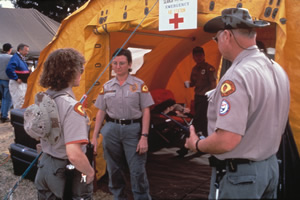Quakes: Shake Out. Don't Freak Out.
'Get Ready Rally' Prepares Community for Statewide Drill
November 4, 2008
By Russ L. Hudson

News media interview officials at Cal State Northridge following the Jan. 17, 1994 earthquake that struck Southern California. The epicenter of the 6.7 quake was three miles from the CSU campus and caused extensive damage.
Cal State Fullerton and community organizations will be out in force Monday, Nov. 10, to share information and materials to help prepare and survive an earthquake. The rally comes three days before the Great Southern California Shake Out earthquake drill in which the campus will participate. (See related story)
The free, public “Shake Out. Don’t Freak Out. Get Ready Rally” will be held from 10 a.m. to 3 p.m. in the university Quad. As part of the rally, representatives from the Red Cross, Community Emergency Response Training, Southern California Earthquake Center, student groups and faculty members will be staffing booths, where visitors can receive information, earthquake kits, participate in games and be entertained.
A panel of fire, police and facilities management representatives and geologists will be answering questions.
“The most important booths will be the earthquake preparedness and the ‘What To Do During an Earthquake’ booths,” said Allison Cone, president of the Geology Club, which did much of the rally’s organizing. “The one that will probably draw the most attention is the earthquake simulator.”

Emergency responders meet outside a Red Cross tent set up at Cal State Northridge following the 1994 quake. Geologists warn that another big quake could cause extensive damage throughout the state, including at Cal State Fullerton.
One rally priority is to stress getting ready: the importance of fastening top-heavy furniture like book cases and refrigerators to walls; stocking food and water; and learning to “Stop, Cover and Hold On,” at the first jolt, getting under sturdy furniture and holding on until the shaking stops, then evacuate and get well away from buildings, in case anything heavy falls off.
“California buildings are designed to stay up after an earthquake,” said David Bowman, chair and associate professor of geological sciences. “You don’t have to worry about being able to get out when the shaking stops. There are more likely to be injuries from heavy objects in the room falling, so protect yourself from those hazards first, then get out when the shaking stops and get away from the building.”
People need to think the situation all the way through, said Cone. “In a strong earthquake, power and water may be unavailable for days, even weeks, and rescue crews and aid organizations like the Red Cross may not be able to get to you for quite some time. You need to stock clean water, food that doesn’t need to be cooked and first-aid supplies. And, think about telling all your friends, neighbors, relatives and co-workers what’s needed so they can prepare.

If a big quake were to strike Cal State Fullerton, the campus could also find itself offering classes in tents, like Cal State Northridge.
“Think about a situation where you have enough water, food, medical supplies and medications and blankets, but your neighbors don’t. What are you going to do when they come to you for water? Can you tell them ‘No’? Will they listen to ‘No’? Everyone needs to prepare,” she said.
“Many universities are participating in the Shakeout,” said Bowman, “but we’re the one going all out with this, including the rally. The July 29 Chino Hills quake that shook the campus, I hope, was a good wake-up call for everyone.”
Related Stories:
Emergency Preparedness: After the (Northridge) Disaster

